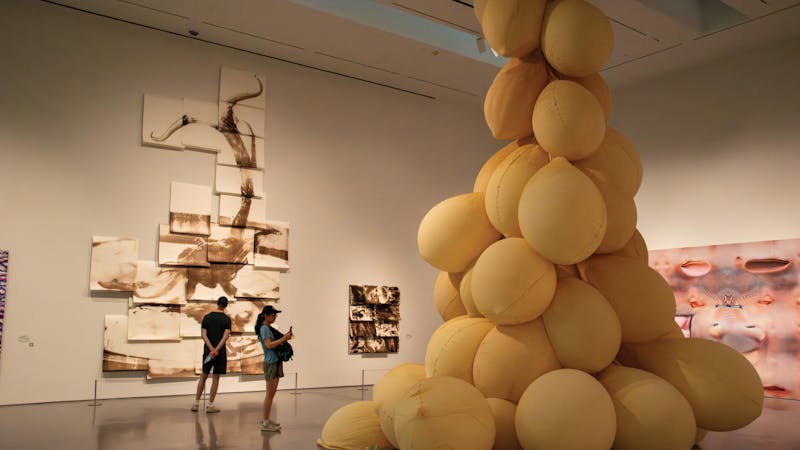TEDx Talks
This past Sunday marked Rice's second annual TEDxRiceU talk series. A TEDx club, sponsored by Catalyst, Rice's Undergraduate Science and Engineering Review, was tasked with organizing this year's event.
TED is an internationally recognized non-profit organization dedicated to spreading "ideas worth sharing."
Sid Richardson junior Rahul Rekhi, Lovett College (CHECK THIS NAME) Hayden something, and Baker College sophomore Adrian Yao were this year's TEDx RiceU coordinators.
This year's line-up included an inventor holding 40 patents, an electrical engineer with a passion for art, a Wall Street businesswoman, a published author, a CEO of a start-up energy venture, the founder of the journal Feminist Economics, a bioengineer creating photography from cells and an internationally renowned energy policy expert.
William Cohn, M.D. and Bud Frazier, M.D.
"The Continuous Flow Total Artificial Heart and the Virtue of Abandoning Biomimicry"
Dr. William Cohn's talk focused on using out-of-the-box thinking to solve complex problems. He explained how he and Dr. Bud Frazier developed the continuous flow artificial heart. He noted that for a long time, pre-existing artificial hearts lasted no more than a year, because they relied upon a pumping mechanism that caused mechanical wear.
The continuous flow artificial heart leverages electromagnets, so there is no mechanical wear.
"It is based on Archimedes screw," Cohn said. He said that a co-worker, while on a trip to Egypt, noticed a couple of men extracted water from a river by turning a device that looked a lot like an Archimedes screw.
According to Dr. Cohn, a pulse is not necessary for somebody to survive, and nor is a heartbeat.
Dr. Frazier recounted a story during the presentation about how, as a young doctor, he was tasked with massaging a young Italian boy's failing heart. "I could see as he tried to reach for my arm," Dr. Frazier said. "He died."
He said that this event motivated him to develop a better artificial heart, one he has witnessed implanted into a number of people, who now live fulfilling lives.
"In our youths our hearts are touched with fire," Dr. Frazier said. "Try to find something that touches you and pursue it with a passion."
Dr. Don Johnson
"Engineering and Art find Common Ground"
J.S. Abercrombie Professor Emeritus Don Johnson began his talk attempting to demonstrate the intersection of engineering and art by saying that, while art historians would manually conduct thread counts for canvases used by painters of the past, he, as an electrical engineer, immediately thinks of spectra with regards to canvas thread counts.
He said he could input a picture of a painting into a signal-processing computer program to determine the horizontal and vertical thread counts that art historians have typically had to manually count.
After presenting a number of graphs illustrating the "warp" and "weft" portions of canvasses of Vincent van Gogh paintings, formulated by the way that the canvasses were initially woven, he said the application of signal-processing to art could lead to a better understanding of the artist's vision for the painting.
"Working at the intersection of engineering and art establishes the legitimacy of interdisciplinary work," Johnson noted.
He said interdisciplinary work across cultures should be more conventional, and encouraged students to praise faculty engaging in interdisciplinary work and striving to break superficial boundaries.
Nina Godiwalla
"Leading from Within: Change your Mind to Change your Life"
Nina Godiwalla, a graduate of the University of Texas at Austin and the Wharton School of Business, spoke of her experience on Wall Street as a second-generation Indian woman. She described how her time at Morgan Stanley motivated her to write the book Suits: A Woman on Wall Street.
In her speech, she spoke about various challenges that business leaders and students alike face in achieving success.
"We all have self-defeating behaviors," she said. "Whether it is procrastination or fear, usually fear of failure, there is something that holds us back."
She noted the danger of blaming factors outside one's control for the lack of success, such as one's boss or workload.
"Whenever I ask somebody what the problem is, why they are not accomplishing as much as they should be, nobody blames themselves," she said. "The thing you have control over is yourself. [...] You can control how you react to somebody else's behavior."
She said that many high-performers' fears that they are not good enough or that they are doing too much may prevent them from taking worthwhile risks. She cited a study in which a group of students deemed intelligent were given the choice to take an easy test or a hard test on a particular subject. A control group of students was confronted with the same choice.
Godiwalla said that the results of the study showed that most of the students deemed intelligent picked the easy test because they were fearful about doing poorly and having their acumen on a particular subject challenged. The other group of students tended to opt for the more challenging test.
Godiwalla concluded the talk by emphasizing the necessity of maintaining self-control.
"There are a lot of things that cause our self-debilitating behaviors, but being able to lead yourself and be self-aware, that is what enables you to get to the next level," she said.
Bryan Hassin
"The Entrepeneur's Journey: How the magic of myth can help us launch ventures, inspire others, and change the world"
As a Global Cleantech Executive, CEO of Smart Office Energy Solutions, Adjunct Professor of Entrepeneurship at Rice University, and Founding Director of GIVEWATTS.ORG, Bryan Hassin is the go-to guy when it comes to entrepreneurship.
During his talk, he worked to dispel the rumor that all entrepreneurs are college dropouts in their twenties who have this incredible idea, works hard to make it a real-life business plan, launches a venture, and then rides into the sunset with a massive IPO.
"The average age of a first time founder is 40 years old," he noted.
He related the entrepreneurial process to that of a heroic tale. "First, there is a call to adventure," he said. He said this usually involves the discovery of a problem or some other phenomena demanding a novel solution. "It is the entrepreneur's job to answer this call," he said. Then comes the wise sage stage, he said.
This is when the entrepreneur thinks he has figured it all out, and that everything will end well.
"Next comes the dark forest; this is where the entrepreneur spends most of their time," Hassin said. After that comes the period of death and rebirth, when the entrepreneur's spirit is reborn, knowing that they are doing something to make a difference.
"And finally, comes the masterful return, in which the hero or entrepreneur comes back to save the day," he said.
Throughout his talk, he noted how entrepreneurship differs from a lot of conventional businesses, in that entrepreneurship promotes divergent, rather than convergent thinking.
"In business, you have a well-defined problem with existing markets," he noted. There is usually a clear end, and the team has to find the means to the end.
"In entrepreneurship, it is different," Hassin said. Many times an entrepreneur will start out with the means, and will find themselves at a number of different ends.
"The most important thing is faith and belief, this is what guides him through the dark forest," Hassin said.
He concluded by addressing all the aspiring entrepreneurs.
"Answer the call to adventures. Life is too short not spend every moment of it pursuing your dreams," he said.
Dr. Diana Strassmann
"Strategic Interventions: Bringing Feminism to Economics"
Dr. Diana Strassmann, the Director of the Program on Poverty, Justice, and Human Capabilities at Rice, as well as the Founding Editor of the journal Feminist Economics, focused her talk on inclusive knowledge.
She said inclusive knowledge welcomes challenges from different perspectives.
"The journal has been another strategic intervention for people to tell different economic stories," she said.
When she said 'strategic intervention,' she was referring to providing an outlet for the people and ideas that originally had neither a voice nor an outlet.
Strassmann said "we need to listen to the voices that have been unrepresented in the development of knowledge." For those people are usually the ones with the big ideas, she noted.
In order to appreciate development, economics requires a theoretical understanding of the whole economy, not just the paid sectors, Strassmann said.
"If we seek to end inequality, we are required to produce gender aware policies."
Strassmann concluded by saying that being aware, and open to different viewpoints is critical to the development of knowledge.
She cited international economics as an example. "For years, GDP per capita has been used as a barometer for how well off a country is," she said. But that does not account for income disparities, and people working in the unpaid sector of society, she said.
Dr. Jeffrey Tabor
"Engineering bacteria to see light, take photographs, and process images"
Assistant professor of bioengineering Jeffrey Tabor delivered a talk on setting the stage for creativity. At first glance, Tabor's talk was about engineering a system to control cells.
"You have this system, which takes input signals, executes certain processes, and then gives you output," Tabor, Postdoctoral Fellow of Department of Pharmaceutical Chemistry, said. Tabor said that his lab has engineered bacteria to react to different light intensities. He showed the audience a high-resolution image of Einstein. This image was completely made up of bacteria, which reacted differently to the different amount of light they absorbed.
Some of this is just old boring engineering, but engineering bactria really allows for some cool advances, Tabor said.
"You build a simple model like the light-signal system (bacterial photography), but this is what sets the stage for creativity," he said.
He added that the light-signal system is just the beginning. He said if bacteria can to react to different signals of light, why then can't they learn to react differently to signals that may trigger uncontrolled cell growth, or cancer.
Amy Jaffe
"The Americas Energy Technology Renaissance: How the US Will be Energy Rich Again"
For the last talk of the evening, Amy Jaffe spoke about the role of energy in the global economy. Jaffe, the Wallace S. Wilson Fellow in Energy Studies and Director of Energy Studies at the Baker Institute for Public Policy, said the issue of distributive energy in the global context is critical.
One-third of the world's population has no access to fuel, and two-thirds has no access to reliable energy, she noted.
"Energy could dramatically change the world if somebody came up with the right solution," Jaffe said.
She recalled a lecture by civic scientist Richard Smalley.
"He claimed that if you take the 10 most important problems or issues our world faces today, and solved the energy problem, you would solve all the other problems on the list," Jaffe said.
She said that she thought his idea was brilliant, as he proposed a transferrable energy solution, in which people could transfer energy from their house to their car, on an as-need basis.
More from The Rice Thresher

Rice loses to UH in Bayou Bucket Classic
The Bayou Bucket will remain with the University of Houston until at least 2030 after Rice football lost to the Cougars Saturday.

Moody Center’s new exhibit blurs the line between body and machine
Swelling latex sculptures, inspired by placentas and umbilical cords have taken up residence in the Moody Center for the Arts. The Barcelona-based artist Eva Fàbregas describes her pieces as forms that grow from “the guts of the architecture,” inflating and wrinkling as if they were alive.

Fizz users and moderators talk fame, challenges
During the volleyball team’s face-off against the University of Texas at Austin on Sept. 3, Jack Vu decided to have a little fun with the scoreboard. An anonymous poster had inaccurately mentioned that Rice beat UT on Fizz, so Vu decided to join in.

Please note All comments are eligible for publication by The Rice Thresher.